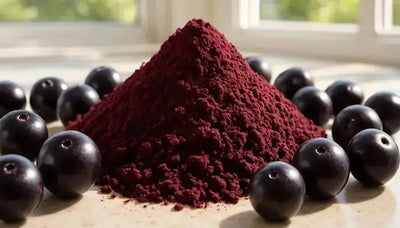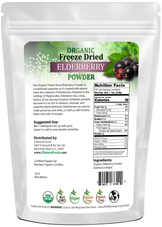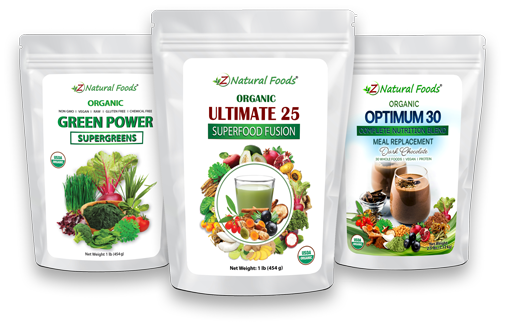Description
Description
In many cultures worldwide, berries are considered a staple in the human diet.
However, while some of these berries are regarded as everyday foods, they are often used as local medicines or tonic foods, depending on the culture.
Does elderberry really work for colds?
Elderberries are one of the most popular cold remedies, with a history of safe and effective usage supported by studies. Therefore, everyone should consider this berry to be a part of their cold and flu season protocol.
For example, Goji berries are not just a staple in the Asian diet but also a primary tonic food and part of the Traditional Chinese Medicine system.
Acai berries and Acerola Cherries are essential staples in the South American diet and are used in various local remedies applications.
Blueberries, Strawberries, and Raspberries are considered common foods in the American diet and are studied worldwide for their powerful nourishing qualities.
Elderberries are considered to be one of the most popular tonic foods during the cold and flu season. When you walk into a health food store, you see an entire section dedicated to all the various forms (powder, capsules, tinctures, syrups, and gummies) of elderberry products and a wide array of formulations that include elderberry as a primary ingredient.
Are the health claims about Elderberry true?
Elderberry has an awe-inspiring history and impressive nourishment profile (containing around 50 milligrams of Vitamin C and 10 grams of fiber per cup), and robust studies justify its use.
In today's article, we will answer two essential questions that we know have been on your mind:
- Are the health claims about elderberry real?
- What are some of the best ways to use elderberry?
You do not often find a tonic food regarded with such praise in multiple forms of medicine. Elderberry is one of them, as it is highly regarded in both Traditional Chinese Medicine and as an integrative tonic in Western herbal medicine.
Elderberry: A Traditional Chinese Medicine (TCM) Perspective
Elderberry, aka Jie Gu Mu, has a valuable place in TCM. Well known for entering the lung, kidney, and bladder meridians, elderberry is most often used to do the following:
-
Clears heat: According to TCM, heat describes a set of internal conditions that may manifest with symptoms like canker sores, nose bleeds, high blood pressure, and anxiety, just to name a few. However, according to TCM, there are two types of heat: Empty and Full. Empty heat is brought on by a Yin deficiency and is characterized by symptoms of dryness. Full heat is Yang and active by nature. The person may feel or look hot and may have a fever.
-
Dispels wind: TCM believes wind is the spearhead of all illnesses because it serves as a vehicle that carries other undesirable influences into the body. In TCM, a cough is associated with different forms of illness. Coughs are related to the element of wind. An individual can have a cough due to wind-cold or wind-heat. Coughs can develop from a yin deficiency, which means the body has too much heat.
-
Resolves dampness: Dampness is described as a feeling of heaviness, fullness, and sluggishness.
-
Tonifies the lungs
-
Expels phlegm: TCM believes that phlegm results from body fluid not being transported adequately by vital energy and accumulating in certain parts of the body.
-
Releases the exterior: This refers to promoting sweating to expel pathogens from superficial levels of the body. Exterior in TCM refers to the location between the muscle and surface of the skin and where your defensive Qi resides. This is the first level of defense against external pathogens.
-
Reduces inflammation: According to TCM, inflammation is a pattern or syndrome of too much fire or heat.
According to Traditional Chinese Medicine (TCM), all foods and herbs have energy. TCM teaches us that foods and herbs have Yin/ Yang energy, five temperatures, five flavors, and four directions.
In these principles, Yin and Yang's action is the general property, and temperature is the extremeness of the properties. In simple terms, Yin is cooling, builds blood, and has downward moving energy. Yang is warming, energizing, and has upward-moving energy.
Because Yang is the heating element, and Yin is the cooling element, those with too much heat are said to have a Yang excess, causing a Yin deficiency. Elderberries in TCM are considered cooling and drying, supporting the release of dampness and heat to help bring the tissue back to a healthier state.
Elderberry: A Western Medicine Perspective
The power of polyphenols
Many health experts believe a diet focused on high amounts of flavonoids is critical to supporting a healthy aging process because these compounds are known as nature’s biological response modifiers.
There are over 8,000 different types of flavonoids found in nature. Based on the research, it does not seem to matter if you acquire them from food or supplements; what counts is the total daily amount you consume. These experts believe we should consume at least 2,000 milligrams of flavonoids daily sourced from various foods and supplements.
Polyphenols are a term used to describe a general category of compounds found in a broad spectrum of fruits, vegetables, and tea that work as “reducing agents” along with other compounds known as antioxidants to support a healthy inflammation response and the body's ability to protect and repair damaged tissue caused by oxidative stress. While over 8,000 polyphenols have been identified, some of the most common are flavonoids, flavonols, and anthocyanins.
Elderberries are extremely rich sources of these specific compounds:
-
Anthocyanins are a part of the flavonoid family of polyphenolic compounds. They represent the pigments that exhibit the bright red, purple, and blue colors found in fruits and vegetables. The six most common are Cyanidins, Delphinidins, Malvidins, Peonidins, Petunidins, and Pelargonidins.
-
Flavonols are polyphenols belonging to the flavonoid family with a ketone group studied for their wide range of biological activities (antioxidant, antimicrobial, hepatoprotective, modulating inflammation, and vasodilation). They primarily accumulate in the outer tissues (skin and leaves) of fruits and vegetables, are the building blocks of proanthocyanins (compounds that are attributed to the colors of fruits and vegetables), and are most widespread in the human diet.
The following was stated In a study looking at the Characterization of anthocyanins and proanthocyanidins in some cultivars of Ribes, Aronia, and Sambucus and their antioxidant capacity:
-
Thirty-one different anthocyanins were detected in these berries, but not every anthocyanin was observed in each berry. Several minor anthocyanins were identified from these berries for the first time. The concentrations of individual anthocyanins in all of the berries were quantified using relevant anthocyanidin 3-glucoside standards.
-
Total proanthocyanidin concentrations in the berries studied ranged from 23 to 664 mg/100 g of FW in elderberry and chokeberry, respectively.
The following was stated in a randomized control study examining how Elderberry Supplementation Reduces Cold Duration and Symptoms in Air-Travellers:
-
Most cold episodes occurred in the placebo group (17 vs. 12); however, the difference was insignificant (p = 0.4).
-
Placebo group participants had a significantly longer duration of cold episode days (117 vs. 57, p = 0.02)
-
the average symptom score over these days was also significantly higher in the placebo group (583 vs. 247, p = 0.05).
Therefore, this data suggests a significant reduction in cold duration and severity in air travelers within the elderberry group.
The misunderstood connection between Elderberry and the Cytokine Storm
In recent years, elderberry has been criticized by reductionist thinkers, who accuse this excellent tonic of causing a cytokine storm. A cytokine storm or hypercytokinemia is a severe immune reaction in which the body releases too many cytokines into the blood too quickly. Having a large amount of them released into the body can be harmful.
A cytokine storm can occur due to an infection, autoimmune condition, or other disease. For clarity, cytokines are communication substances released by white blood cells. Some examples of cytokines are interleukins, which propagate all immune cells, and interferons, which stimulate infected cells to produce proteins that interfere with viral replication. The following studies provide evidence showing why the connection between elderberry and cytokine storms is untrue.
A study released in 2001 showed that an extract of elderberries could help prevent viral infection by stimulating cytokines in HEALTHY individuals. Nowhere in this study did it refer to or speak of Elderberry's connection to a cytokine storm.
Another study released in 2016 showed an anti-cytokine effect using an elderberry formula to treat atherosclerosis (inflammation of the arteries).
These studies are excellent proof that herbs are capable of working differently in different situations.
Therefore, it is safe to conclude that
Elderberry can help the body’s immune response and immune suppression response.
What are some of the best ways to use elderberry?
Elderberry has many powerful and effective attributes when used as a simple or individual tonic based on its various mechanisms of action. However, there are many other incredible herbs that, when combined with elderberry, can support and modulate elderberry’s primary action.
Many herbalists and integrative doctors use boneset, Echinacea, Yarrow, Ginger, Andrographis, and Elderberry in various blends as critical components of their cold and flu wellness protocol.
These herbs are used to create multiple protocols and blends based on dosage, time frame, and stage of the ailment to support one or more aspects of the healing process of numerous pathogens.
However, it is essential to use the correct parts of the plant to obtain specific benefits. The aerial or above-ground portion of medicinal plants often contains specific compounds either not found in the root or in higher concentrations and vice versa.
So, picking the proper part or parts of the plant when creating a formula is essential to nourish a specific response. An excellent example of this is the herb echinacea. The root is more concentrated in alkylamides, which may support a healthy inflammation response and is best for the acute stages. It is often used in high amounts for short durations. The ariel portion is more concentrated in lipoproteins and polysaccharides, which are known to stimulate and strengthen our constitutional response in small quantities over an extended period.
For example, medical doctor and herbalist Aviva Romm suggests the following:
-
Combine equal parts of Echinacea glycerite, Elderberry syrup, anise seed extract, and catnip extract, taking one dropperful 4-6 times daily for at least one week or until recovered.
-
She also suggests using equal parts black cohosh and Jamaican dogwood extracts at 3 ml every 15 minutes for the first hours and then every two hours for those aches and pains associated with a cold or flu for adults. She suggests dividing their body weight by over 150 so children can get a more appropriate dosage. For example, if the child weighs 30 pounds, you would divide 30 into 150, which comes out to ⅕ the amount. She recommends not to exceed the specific amounts in the aches and pains formula.
In conclusion, this research shows that elderberry has a wonderful history of safe and effective usage, with human studies supporting its claims as an individual tonic and when properly combined with other herbs.
Therefore, everyone should strongly consider this powerful medicinal to be a part of their cold and flu season protocol.
For more information about our Organic Elderberry, visit our product description here:
















